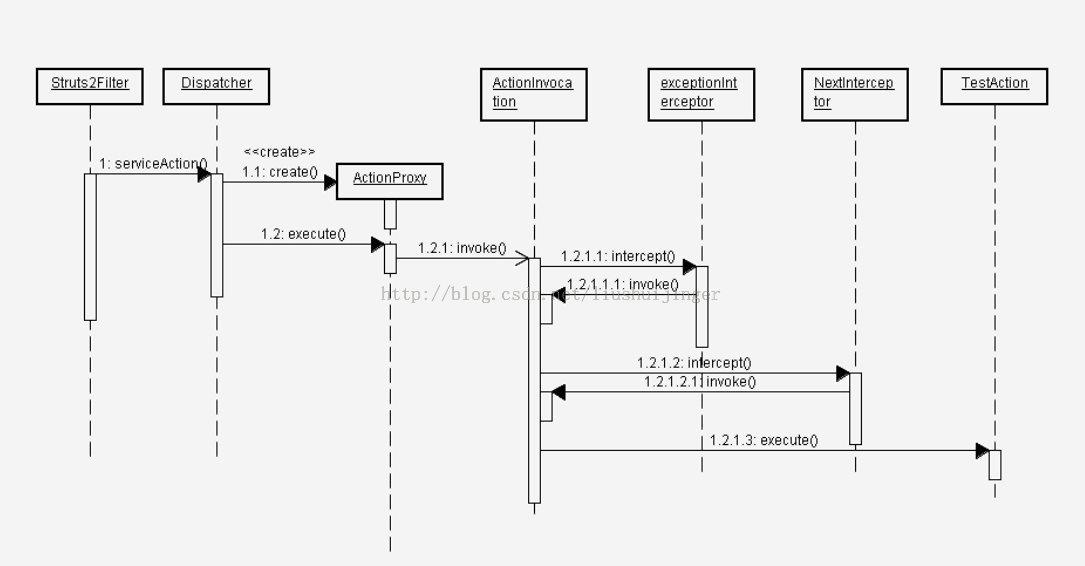前面说完了Spring、Hibernate,很自然今天轮到struts了。struts的核心原理就是通过拦截器来处理客户端的请求,经过拦截器一系列的处理后,再交给Action。下面先看看struts官方的工作原理图:

图1 struts原理图
简单分析一下:首先客户端发来HttpServletRequest请求,传递给FilerDispatcher(ActionMapper是访问静态资源(struts的jar文件等)时用的,平时很少用),然后FilerDispatcher会为我们创建一个ActionProxy,ActionProxy会通过ConfigurationManager获得struts.xml文件中的信息,ActionProxy拥有一个ActionInvocation实例,通过调用ActionInvocation的invoke()方法,来挨个处理Interceptor,最后处理Action,接着Result返回,再逆序经过Interceptor,最后得到HttpServletResponse返回给客户端。
如果不太明白呢,那就看看下面这张时序图,也许你就懂了:

图2 struts原理时序图
上面的时序图逻辑就比较清晰了,我就不过多解释了。看完struts的原理图,我们还是需要通过代码来进一步了解它具体是怎么实现的。首先,我们需要一个ActionInvocation:
package com.tgb.struts;
import java.util.ArrayList;
import java.util.List;
public class ActionInvocation {
List<Interceptor> interceptors = new ArrayList<Interceptor>();
int index = -1;
Action a = new Action();
public ActionInvocation() {
this.interceptors.add(new FirstInterceptor());
this.interceptors.add(new SecondInterceptor());
}
public void invoke() {
index ++;
if(index >= this.interceptors.size()) {
a.execute();
}else {
this.interceptors.get(index).intercept(this);
}
}
} 我们实现的ActionInvocation是将Interceptor写在里面的,但实际上是通过反射加载的,原理同之前写的Spring与Hibernate的博客,相同的代码就不在这里占用篇幅了,也没啥意思。不知道怎么实现的朋友请查看前面几篇博客。
接下来是我们的Interceptor接口以及两个简单的实现:
package com.tgb.struts;
public interface Interceptor {
public void intercept(ActionInvocation invocation) ;
}
package com.tgb.struts;
public class FirstInterceptor implements Interceptor {
public void intercept(ActionInvocation invocation) {
System.out.println("FirstInterceptor Begin...");
invocation.invoke();
System.out.println("FirstInterceptor End...");
}
}
package com.tgb.struts;
public class SecondInterceptor implements Interceptor {
public void intercept(ActionInvocation invocation) {
System.out.println("SecondInterceptor Begin...");
invocation.invoke();
System.out.println("SecondInterceptor End...");
}
} 然后就是我们的Action:
[java] view plaincopy在CODE上查看代码片派生到我的代码片
package com.tgb.struts;
public class Action {
public void execute() {
System.out.println("Action Run...");
}
} 最后是我们的客户端调用:
